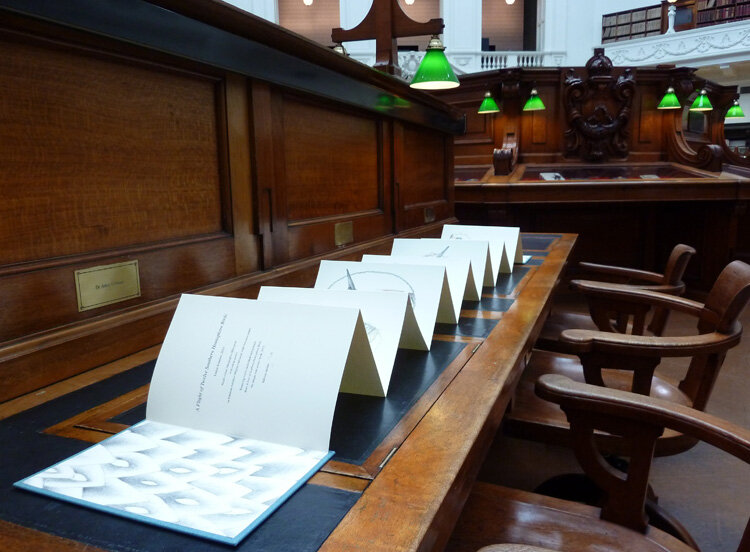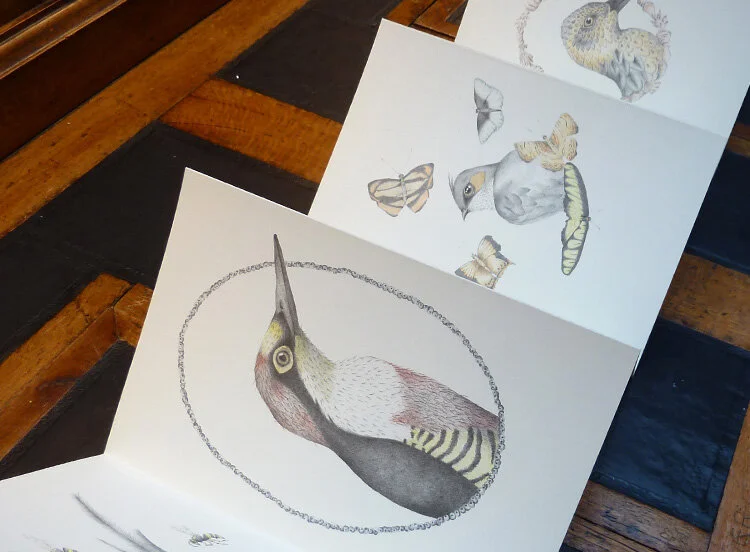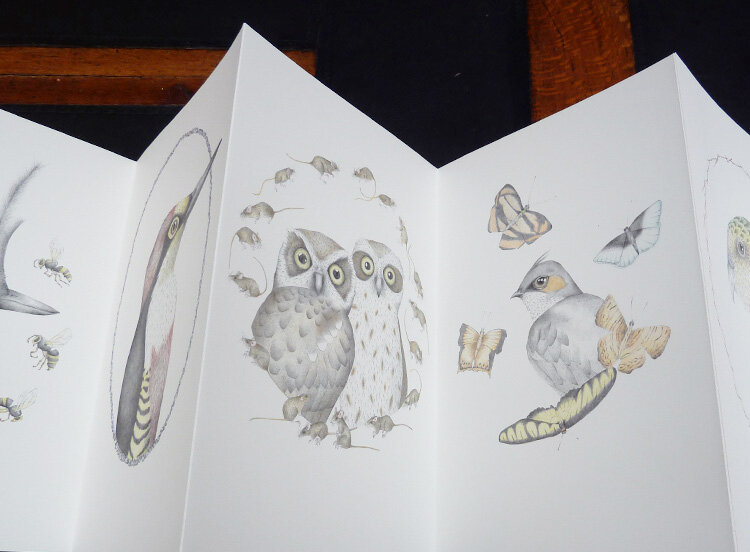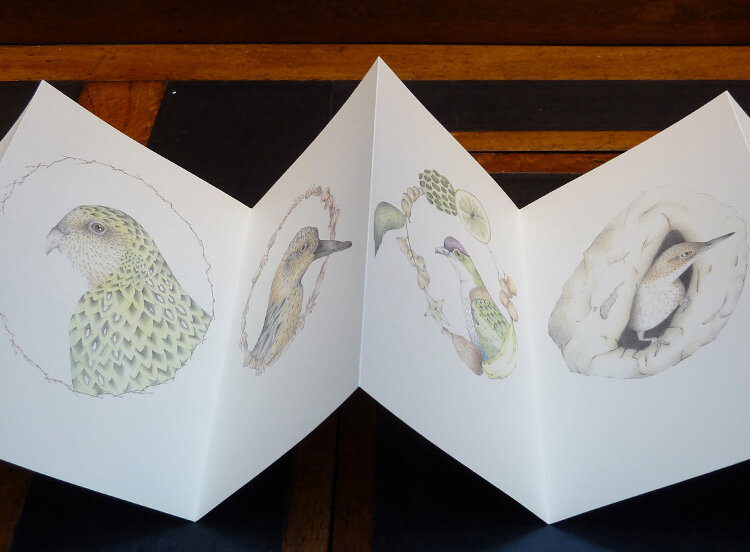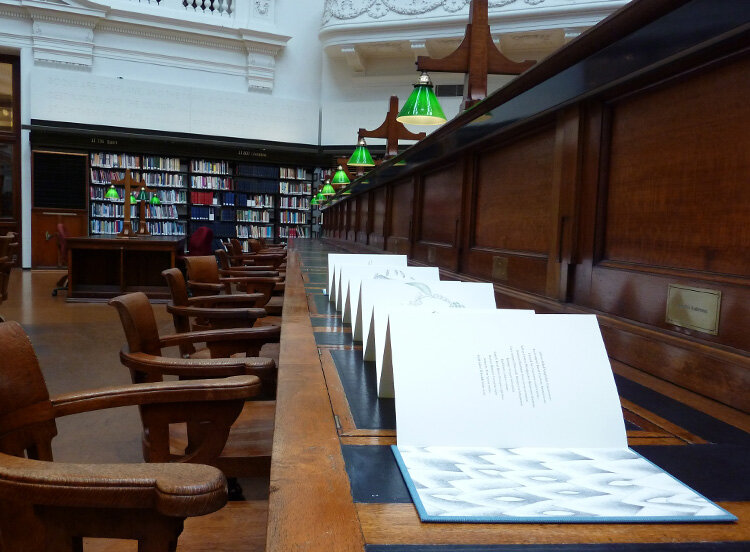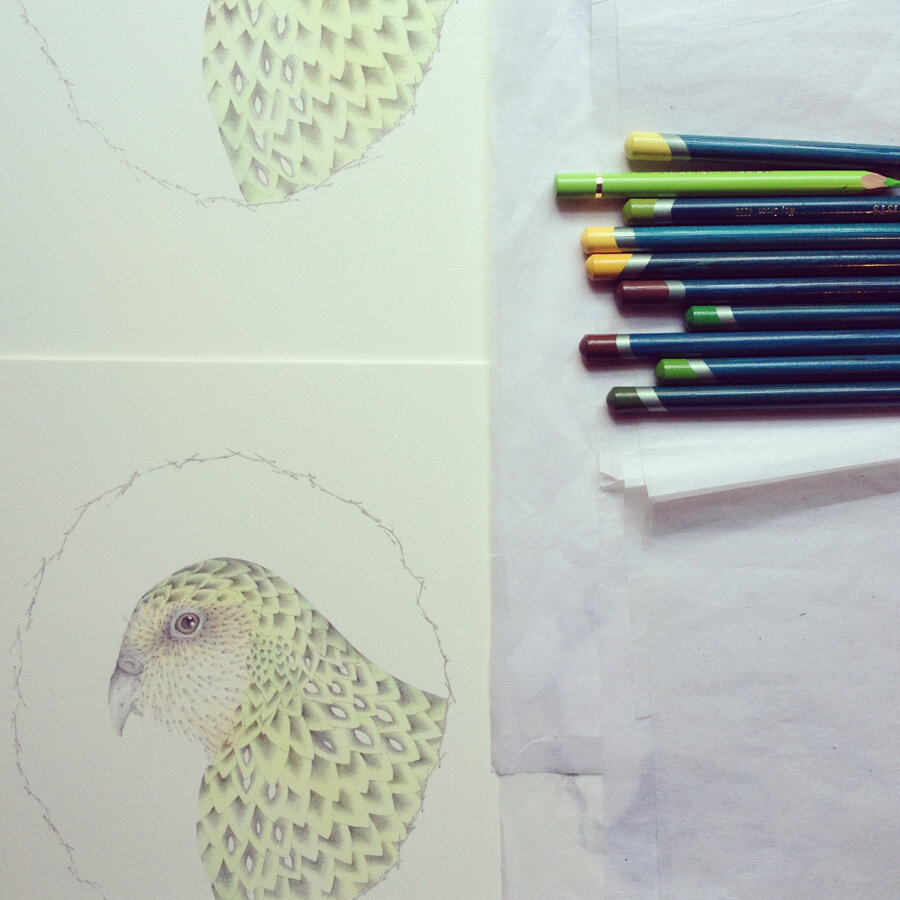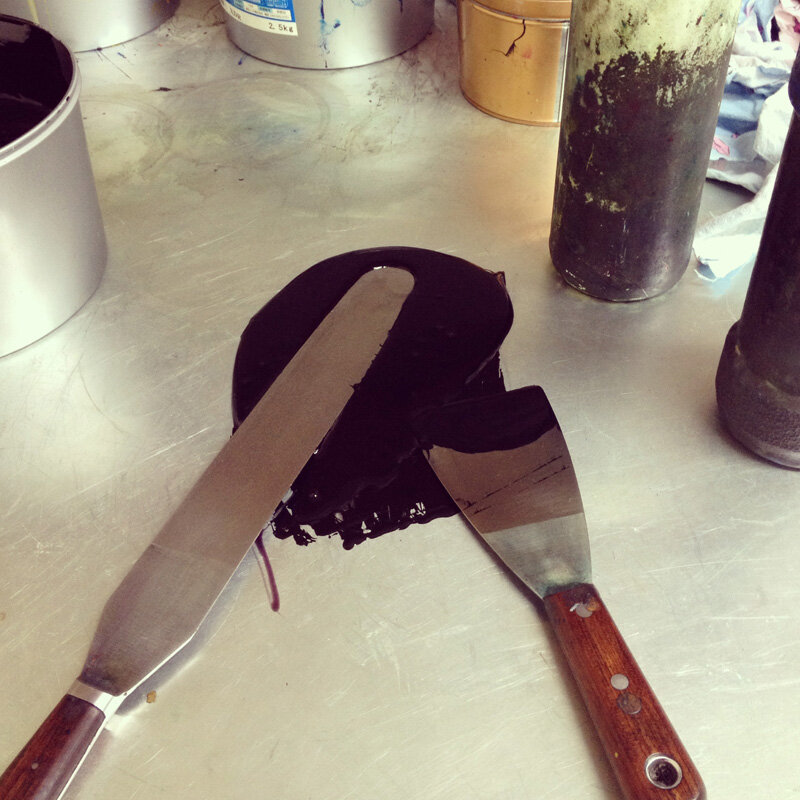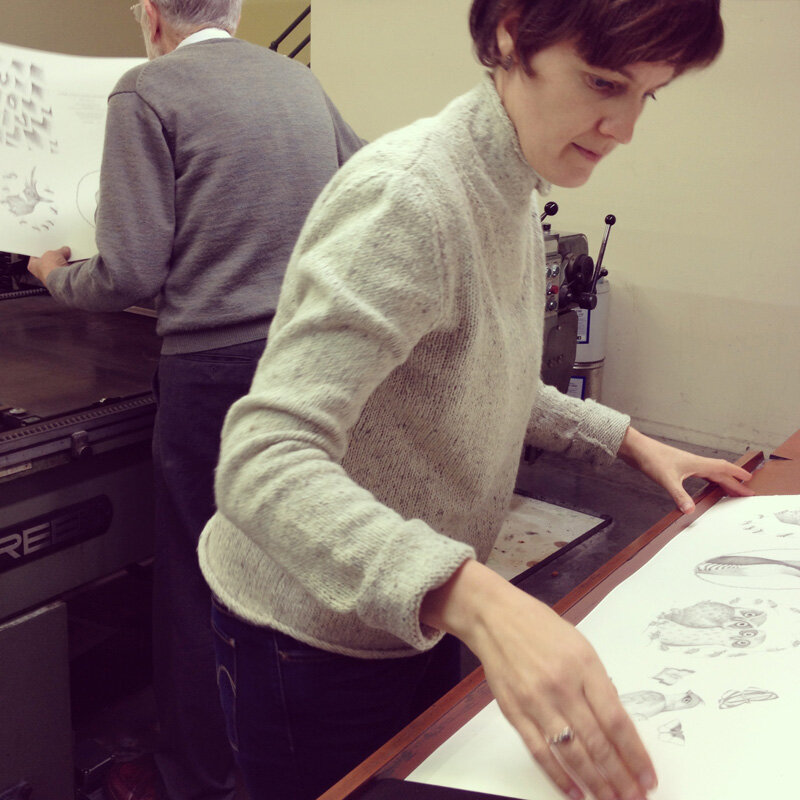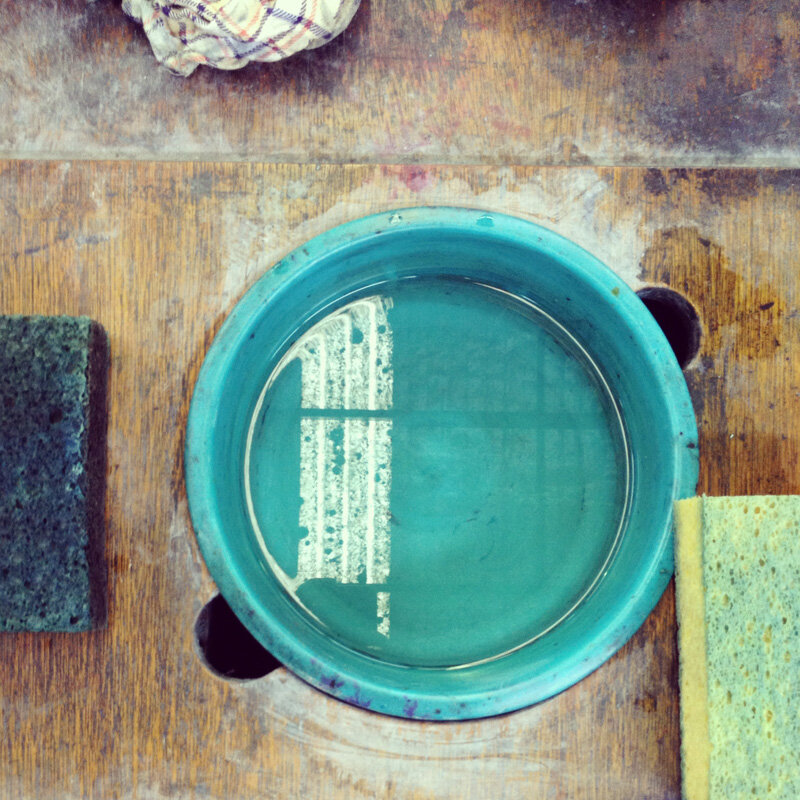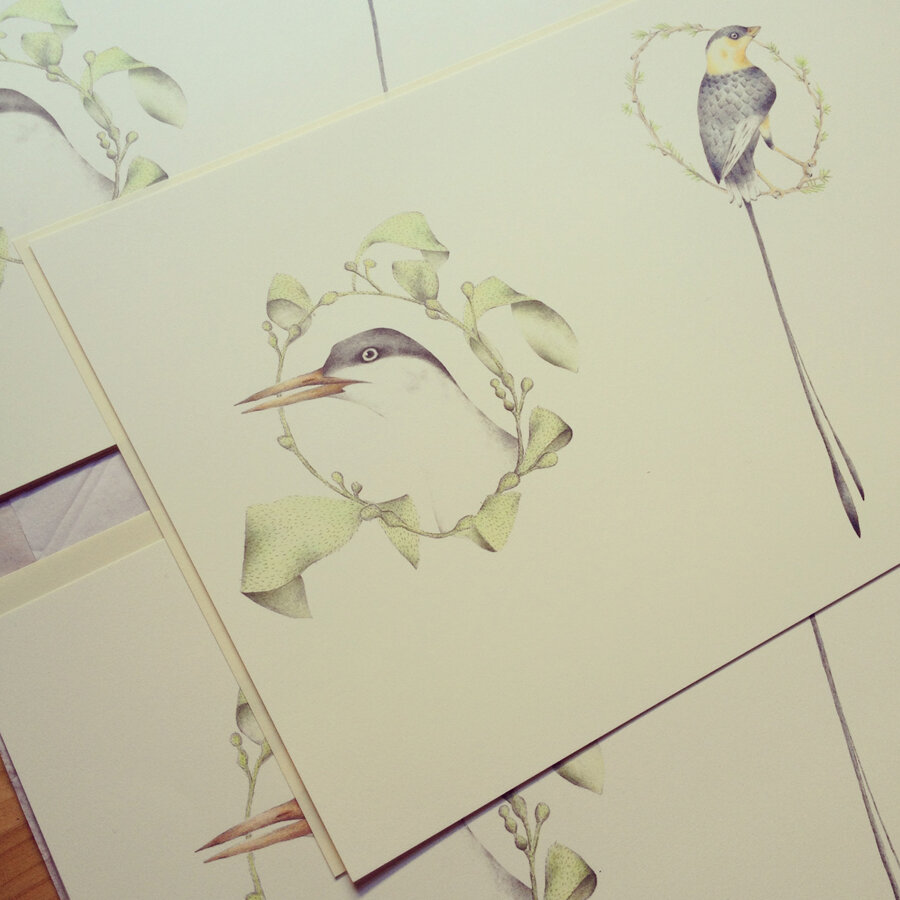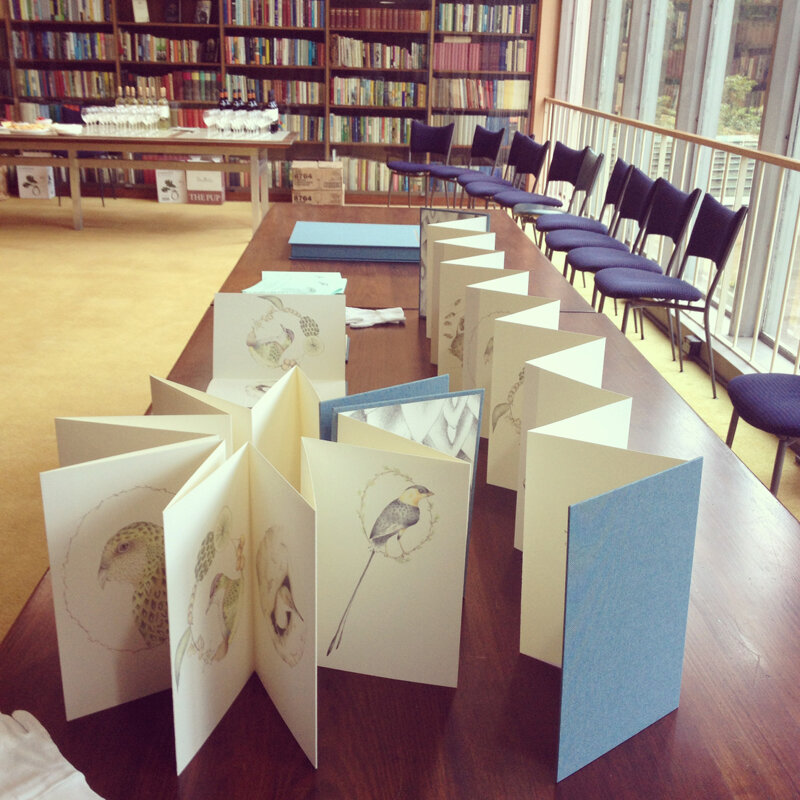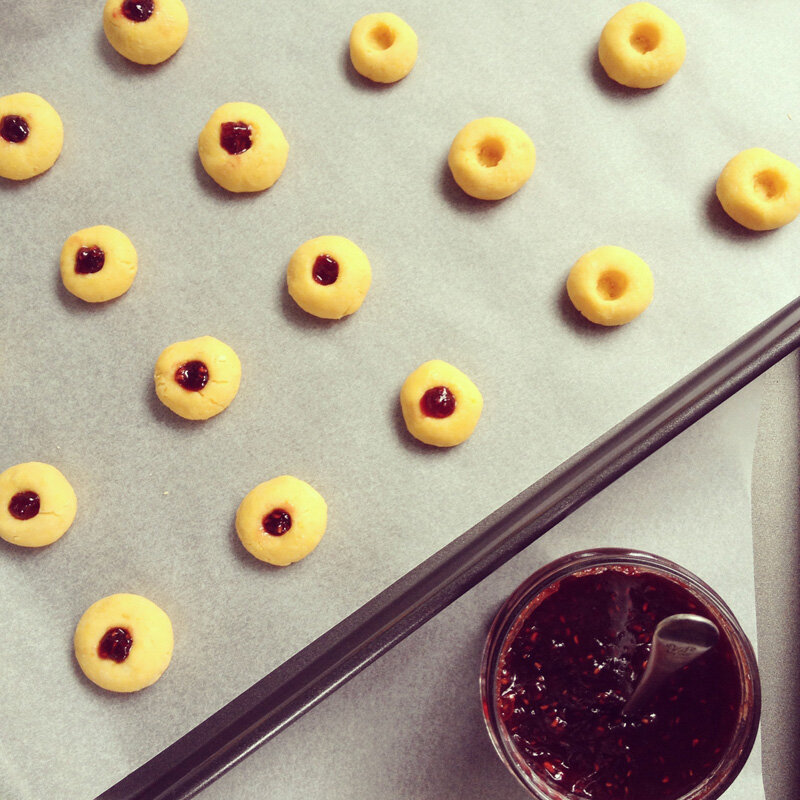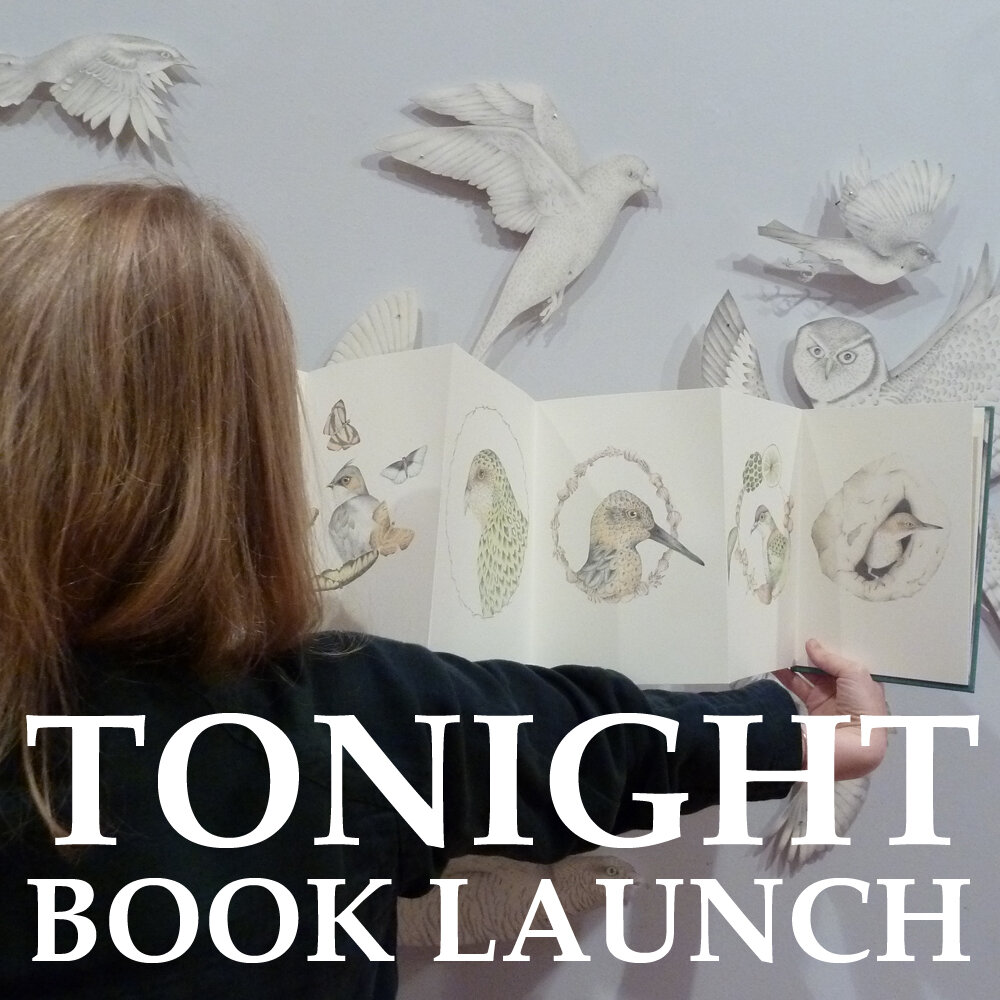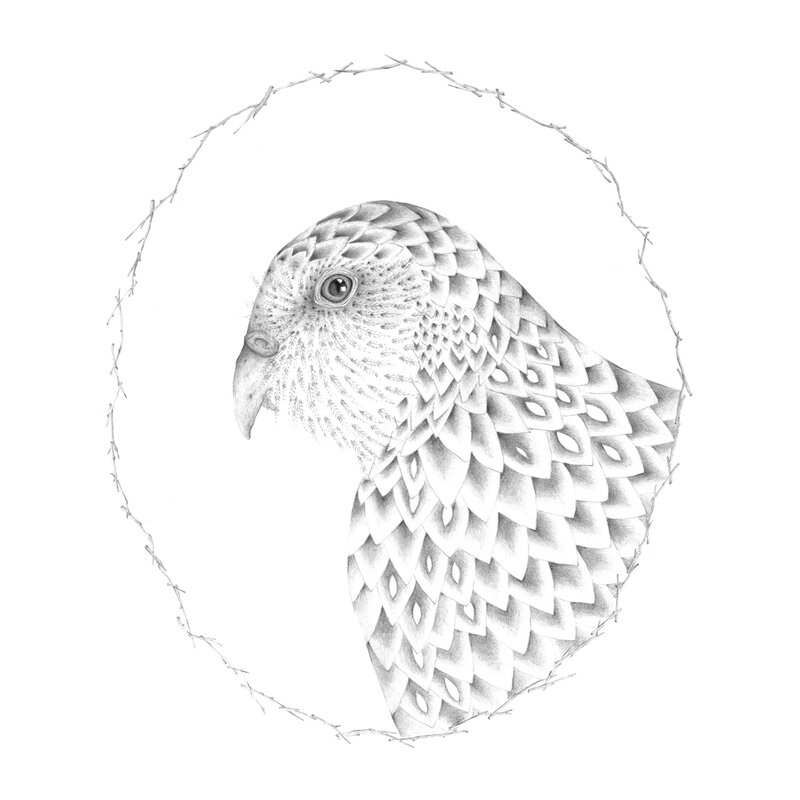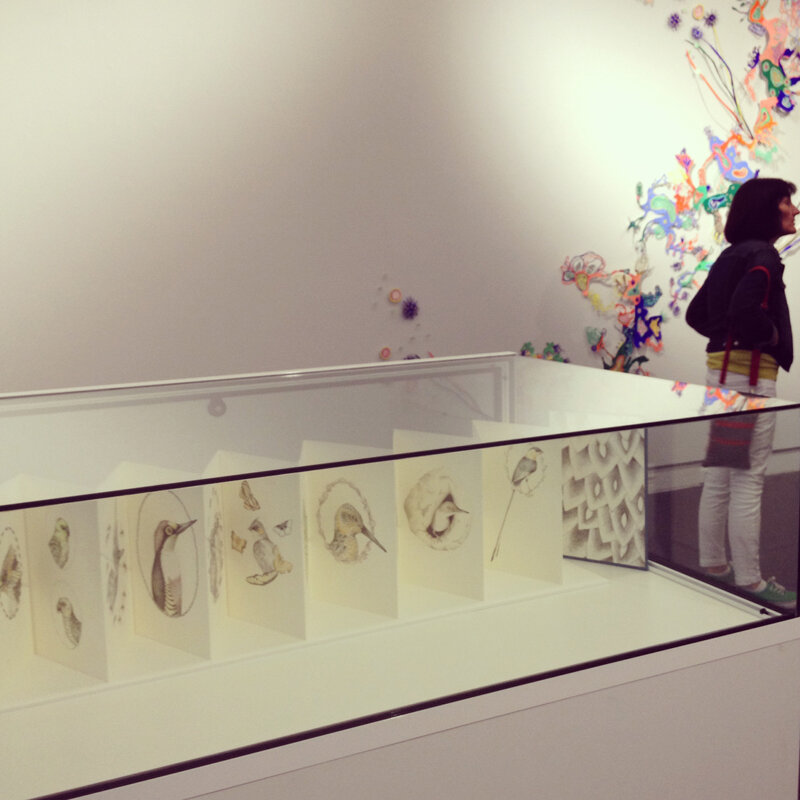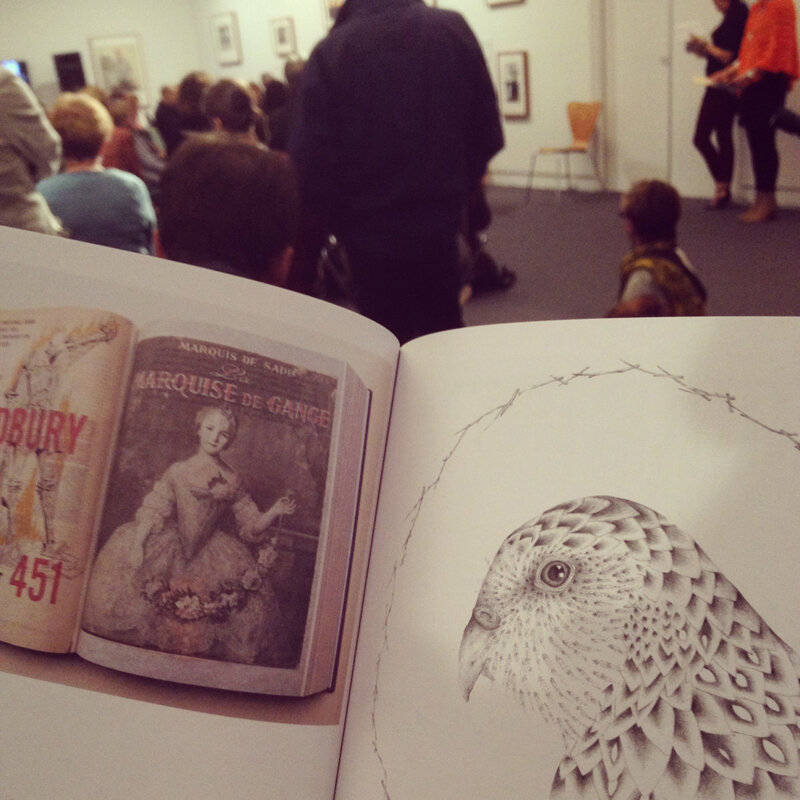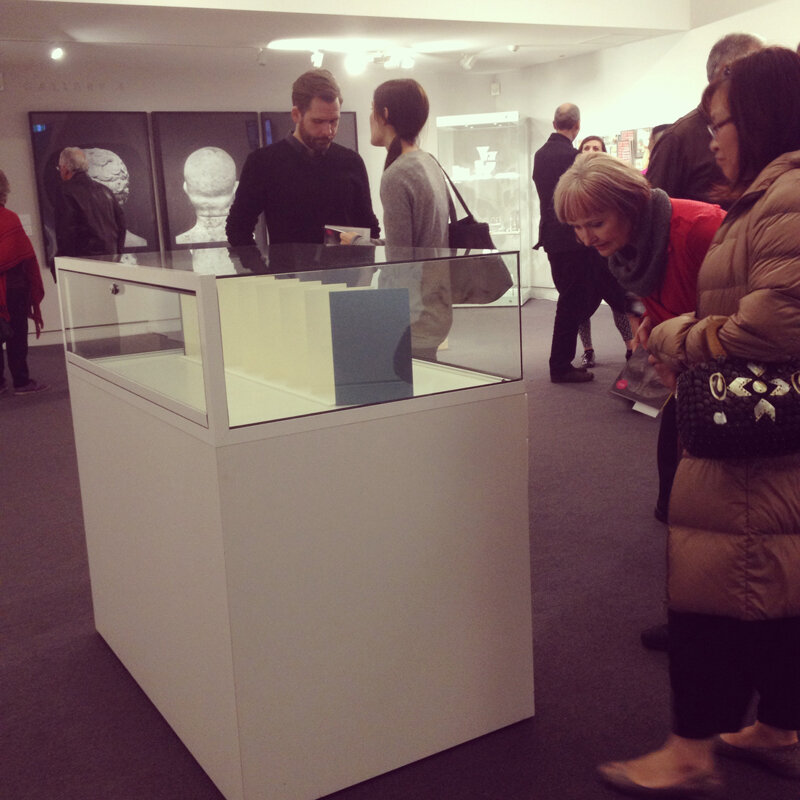A FLIGHT OF TWELVE SOUTHERN HEMISPHERE BIRDS
This artists’ book, A Flight of Twelve Southern Hemisphere Birds, was launched alongside A Year of Southern Hemisphere Birds in the Leigh Scott Room of the Baillieu Library, University of Melbourne, 2013.
Louise Jennison
A Flight of Twelve Southern Hemisphere Birds
2013
16 page concertina artists’ book, single-colour lithographic offset print with pencil on Fabriano Artistico 300gsm traditional white hot-press paper
Printed by Redwood Prints
Bound in blue linen by Louise Jennison
Edition of 10
This artists’ book was launched alongside A Year of Southern Hemisphere Birds on Wednesday the 23rd of October in the Leigh Scott Room of the Baillieu Library, University of Melbourne, 2013. It was opened by writer and curator, John Kean, accompanied by an explorer’s narrative by Gracia Haby.
It features the hand-coloured portraits of the Yellow-billed kingfisher (Syma torotoro); Red-rumped parrot (Psephotus haematonotus); Crested jay (Platylophus galericulatus); Yellow-fronted woodpecker (Melanerpes flavifrons); Southern boobook (Ninox novaeseelandiae); Grey-rumped treeswift (Hemiprocne longipennis); Kakapo (Strigops habroptilus); Red knot (Calidris canutus); Superb fruit-dove (Ptilinopus superbus); Rufous hornero (Furnarius rufus); Antarctic tern (Sterna vittata); and the Shaft-tailed whydah (Vidua regia).
In both works, the bird is shown as living creature to respect and to be in awe of, and as something not so very different to ourselves. The homes we build, the lives we lead, the desires we hold, the foods we eat, the patterns we form, the knowledge we hold, and our means to survive: are we all more similar than not?
Editions of this artists’ book reside in various collections, including the University of Melbourne Library, the State Library Victoria, the State Library of NSW, the State Library of Queensland, and Monash University Library.
An edition of this artists’ book was exhibited as part of the 2014 National Works on Paper exhibition at Mornington Peninsula Regional Gallery. The work was acquired with funds from the Mornington Peninsula Shire.
﹏
RELATED LINK,
A YEAR OF SOUTHERN HEMISPHERE BIRDS
RELATED POSTS,
BIRDS, WE’RE CURIOUS FANS
DOWN UP
WITH GREENISH PLUMAGE
FLYING IN THE LIBRARY
ALL MY PRETTY CHICKENS, GLIDE, SOAR, FLUTTER, PERCH
FEATHERY QUARTET
A BOOK IN THE LIBRARY
A VERY FINE LAUNCH IN THE SOUTHERN HEMISPHERE
A FEATHERED EXPLORER'S HAT
A MEDIUM SIZED BIRD WITH A WINGSPAN EQUAL TO THAT OF A 30CM RULER
PARROTS, CINDERELLA, AND A WOODLAND GLADE
A LAUNCH DRAWS NEARER
FEATHERED INVITATION
WITH PENCIL IN HAND
A SPRING DASH
A FLIGHT OF TWELVE SOUTHERN HEMISPHERE BIRDS
FROM MEMORY
Speech notes for Louise Jennison’s A Year of Southern Hemisphere Birds, and A Flight of Twelve Southern Hemisphere Birds
John Kean, writer and curator
Artists’ book launch
Wednesday the 23rd of October, 2013
Leigh Scott Room, Baillieu Library, University of Melbourne
It is a joy to be asked to launch this exhibition for it brings together two of my great loves, birds and works on paper.
Louise Jennison’s A Year of Southern Hemisphere Birds are depicted to scale, each bird, one for every month of the year, is encircled by the food it eats or the items it uses (such as the sticks cleared by the Kakapo to make a stage from which to woo a mate).
The circle that encloses each bird is of course more than a decorative motif; it is a metaphor. Open yourself to this seasonal cycle and you can embark on imaginative journey, not just around the Southern Hemisphere but also through great natural cycles and geological time. Take a peep though these pages and glimpse the creative process for a moment, before we must reenter the banality of linear time.
Let’s look for a moment at the exhibitions materiality.
Housed in a Solander box of turquoise linen with an interior lined gold, this Year of Birds recalls the work of the artists and scientist of the European Enlightenment. Daniel Solander was a botanist who had trained under Linnaeus at Uppsala and who travelled with Joseph Banks and Sydney Parkinson on James Cook’s first expedition to the Southern Hemisphere. The box, invented by Solander for the care of his specimens, like everything else about this exhibition is carefully chosen and meticulously planned. Right down to the Fabriano Artistico 300gsm traditional white hot-press paper on which the images are drawn and printed.
In what is an ongoing and remarkably productive collaboration Gracia Haby has written an exhilarating and absolutely true explorer’s narrative housed with Louise Jennison’s immaculate drawings in the Solander box. Using Gracia’s notes as a guide I would like to take a quick spin through the seasons, and to make a couple of brief detours following the trail of birds that have touched me.
JANUARY
Yellow-billed kingfisher
Exotic to us, the bird is common in the wet forest near Lae in New Guinea, but proved elusive
to the artist/explorer.
FEBRUARY
Red-rumped parrot
Reminds the intrepid artist of love. Perhaps the red rump is remnant from Cupid’s arrow. But it is just February and I will return to this locally abundant species a little later.
MARCH
Crested jay
Evoked millinery envy but was drawn rather than bagged as a specimen.
APRIL
Yellow-fronted woodpecker
A resident of North West Argentina this woodpecker proves that like the weather you can take bird-watching anywhere you go.
MAY
Southern boobook
This bird should teach us about the anthropological concept misrecognition. Just because it has large frontally located eyes we assume it intelligent. This is not the case. Corvids and parrots are much smarter. It is paradoxical then that I was shown one by a Professor, roosting on a ledge near the Murdoch Theatre here at the Uni. Beetles, not my learned colleagues, attracted it.
It is often heard at night when we sleep under canvas. Boobook! Boobook!
JUNE
Grey-rumped Treeswift
Reminds the artist travellers of lost opportunity and melancholy, they rarely roost.
JULY
Kakapo
This charismatic large flightless green Parrot of the Land of the Long White Cloud. The family diverged from the other parrots around 82 million years ago when New Zealand broke off from Gondwana, while the ancestors of the genera Nestor (including the Kaka and the Kea) and Strigops (the Kakapo) diverged from each other between 60 and 80 million years ago.
It is a tragic bird that has miraculously dodged the bullet of extinction. Males isolated have lots of testosterone and not enough mates. You may remember the extraordinary footage where the bird tried to mate with Stephen Fry’s companion, zoologist Mark Carwardine's head, one wonders how intelligent that remarkable hybrid would be.
It is nocturnal and should remind us of the diurnal cycle that rules our daily lives.
Let's return to the Red-rumped parrot for a moment, for unlike the large green parrots of New Zealand the ancestors of this bird stayed on our continent as it drifted north and dried out.
I brought in this specimen to illustrate how other cycles affect us. I collected this bird from under a tree at Carlton Gardens. It expired due to the extraordinary stresses that led up to the Black Saturday Fires. Australia has always suffered from the droughts driven by the southern oscillation and the effect of El Nino. Humans are accentuating these cycles and artist can work to sensitize us to our place in nature.
AUGUST
Red knot
The knot is a great traveller; seen around our coast in summer it bears a mottled plumage that melds in with the sandy shorelines and estuaries. Why then the Red knot? The knots in their thousands fly to breeding grounds in Siberia and Alaska where they nest is the russet like their plumage. If you see them in March at Mud Island or massed at Broome their feathers already red in preparation. Their providential stopover sites at on the Yellow River and Korea are threatened however imperiling their remarkable migrations.
SEPTEMBER
Superb fruit-dove
Included because they are superb in the colour, vermillion, purple and emerald. Also they are blessed with vision into the ultra violet range, so they can perceive the exact ripeness of their preferred fruit.
OCTOBER
Rufous hornero
The builder of deceptive mud nests in South America. Their nests have an extra chamber to trick predators and human’s build superstitions around them. In catholic South America they never work on their nest on Sunday's.
NOVEMBER
Antarctic tern
Another great traveller, the Antarctic tern is as free as the wind driven hard at high latitudes. It is a very beautiful bird proving that form follows function.
DECEMBER
Shaft-tailed whydah
This sparrow like bird from Mozambique reminded the explorer/artists of their mortality. The existential question, why grow a very long tail, that makes you exceptionally vulnerable to predators for a moments sexual satisfaction.
It is a little like asking an artist why they make art, the answer being, THAT IS WHAT WE MUST DO!
Jennison shows the bird as living creatures not so very different to ourselves. “The homes we build, the lives we lead, the desires we hold, the foods we eat, the patterns we form, the knowledge we hold, and our means to survive: are we all more similar than not?”
That is a very deep question, for more than 150 million years of evolution have separated us as mammals from the reptilian lineage of today’s birds. So I will leave the question hanging as something to consider when you look at the drawings and prints and not seek any resolution.
For all its modesty and whimsy A Year of Southern Hemisphere Birds is a thought-provoking exhibition. A meditation of cycles of nature and an invitation to slow down and experience our relationship to the living world.
It gives me great pleasure to commend the exhibition to you and launch the show and the artist’s Boobook!
